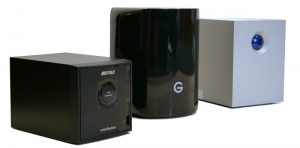 Sure, most data loss could be prevented, but technology is complicated, hardware fails, people make mistakes, and society is often running at high speed. Hopefully we can shed some light on RAID failure, data recovery for RAID devices, and why you still need a backup solution when you have a RAID.
Sure, most data loss could be prevented, but technology is complicated, hardware fails, people make mistakes, and society is often running at high speed. Hopefully we can shed some light on RAID failure, data recovery for RAID devices, and why you still need a backup solution when you have a RAID.
Redundant arrays of disks can help expand storage capacity, and they are sometimes one part of an overall hardware redundancy strategy. In some cases, when configured with battery backups (UPS), redundant power supplies, and redundant disks, servers can continue to work even when there is a hardware failure. Of course this means someone needs to monitor the server or there needs to be an automated alert for failures, and the automated alert system needs to be tested, often. Even with everything running as intended, you should not consider RAID to be your backup solution.
If someone accidentally deletes a file, makes an incorrect change to data, or you suffer a virus or ransomware attack, having a RAID really does nothing for you. The data is gone or changed, for good. Another problem with relying on RAID as a “backup” is the monitoring that’s required as well as proper configuration in the beginning.
The unrecoverable 2-drive server RAID cases we see in our RAID recovery lab are not always the result of businesses owners or office workers configuring and maintaining their own critical data storage. We have seen cases where a local computer shop tech has configured the customer’s 2-drive server as RAID-0 (Zero Redundancy). Maybe it’s a mistake or they just didn’t know what it means. In some cases the business owner asked them to purchase a server and make sure it has RAID “for a backup”. With RAID-0 they just increased the probability of a hard drive failure and lost data. If they get it right and use RAID-1 (mirroring) at least they have a good chance of recovering if they have a hardware failure, which is really the point – to quickly recover from hardware failure and maintain a satisfactory uptime.
Another common case for RAID recovery is RAID-5 where there are 3 or more disks and zero hot-spares. This configuration allows for one drive failure because the data is distributed in a manner that allows the failed drive to be rebuilt from data stored on the other RAID members, but here is the catch: someone needs to be alerted when the first failure happens so they can replace the failed device. Once a second device fails then it’s time for data recovery. Not monitoring the RAID is a common problem in servers, network attached storage (NAS), and external devices like LaCie 4-Big and G-Technology multi-drive devices. Even with proper monitoring, you really need a backup solution in place. You should not count your RAID as your backup solution.
It’s not uncommon for a small business owner to call a local support service or computer shop after a RAID failure. If the support service does not have a RAID specialist on staff then a number of things can go wrong. When a technician has no training for a service they are trying to provide, they have no idea what they don’t know. This leads to actions that can destroy any chance of a good recovery just because they didn’t know any better. Re-initializing the drives, formatting, or worse, reusing one or more of the drives to reinstall the operating system can all lead to partial and sometimes total data loss. Yes, we have seen all of these mistakes.
Another common recovery scenario involves RAID-0 and JBOD configurations in large storage devices. Some of the big storage devices being sold today are 2 or more devices configured as a single large storage volume. Many of the devices are marketed to photographers and video professionals to satisfy their growing storage needs. While some high-end multi-drive devices are sometimes pre-configured for redundancy, many devices are configured for maximum capacity and no redundancy. If one disk drive fails, you lose everything. The following are some examples of storage devices that consist of 2 drives but there is no redundancy at the advertised 20TB capacity:
- 20TB Western Digital My Book Duo
- G-Technology 20TB G-RAID
- WD 20TB My Cloud
- LaCie 2-Big Dock RAID 20TB
If you plan on using this type of personal storage device at the full capacity, you should plan on buying at least two of them so you can maintain a backup of your data.
Data loss can be devastating for anyone. We have seen it with individuals, newlyweds, parents, students, professors, small business owners, teachers, government workers, engineers, artists, photographers, videographers, designers, software developers, lawyers, doctors, dentists, the list goes on and on. If you find yourself in need of RAID recovery, please consider our flat-rate RAID recovery service.